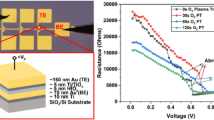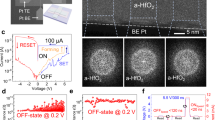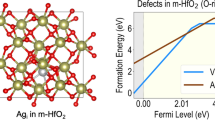Abstract
A comprehensive physical electro-thermal modeling approach is explored to investigate the intricate mechanisms underlying filament formation and the effect of surface perturbation in nanoscale Y2O3-based memristors. The approach integrates fundamental principles of solid-state physics, electrochemistry, and materials science to develop a detailed physical model that captures the key phenomena governing the operation of Y2O3 memristors. The simulation is carried out in a semiconductor physics-based tool, i.e., COMSOL Multiphysics with a defined MATLAB script, wherein simulation is based on the minimum free energy of the used materials at an applied input voltage. The fundamental processes in filament growth include ion migration, redox reactions, and vacancy dynamics within the Y2O3 lattice. Furthermore, the influence of surface perturbation on the overall device behavior, grain boundaries, and electrode interactions impact on memristor performance is also investigated. The surface perturbations significantly influenced the switching dynamics of the memristor, including variations in switching voltages, ON/OFF current ratio, filament radius, and filament temperature during the switching process. Therefore, the presented findings contribute to a deeper understanding of the physical mechanisms at play in Y2O3 memristors, offering valuable guidance for the design and engineering of these nanoscale devices for next-generation memory and neuromorphic computing applications. This physical modeling approach not only enhances our comprehension of memristor behavior but also paves the way for the development of more efficient and reliable memristor-based technologies.







Similar content being viewed by others
References
Y. Nam, I. Hwang, S. Oh, S. Lee, K. Lee, S. Hong, J. Kim, T. Choi, and H.B. Park, Switchable Schottky diode characteristics induced by electroforming process in Mn-doped ZnO thin films. Appl. Phys. Lett. 102(16), 1621051 (2013).
G. Ding, S.T. Han, C.C. Kuo, A.L.V. Roy, and Y. Zhou, Porphyrin-based metal-organic frameworks for neuromorphic electronics. Small Struct. 4(2), 1 (2023).
L. Gao, Q. Ren, J. Sun, S.T. Han, and Y. Zhou, Memristor modeling: challenges in theories, simulations, and device variability. J. Mater. Chem. C 9, 16859 (2021).
G. Pedretti and D. Ielmini, In-memory computing with resistive memory circuits: status and outlook. Electronics 10(9), 1063 (2021).
H. Akinaga and H. Shima, Resistive random-access memory (ReRAM) based on metal oxides. Proc. IEEE 98(12), 2237 (2010).
S.H. Lee, X. Zhu, and W.D. Lu, Nanoscale resistive switching devices for memory and computing applications. Nano Res. 13, 1228 (2020).
S. Kumar, M. Das, M.T. Htay, S. Sriram, and S. Mukherjee, Electroforming-free Y2O3 memristive crossbar array with low variability. ACS Appl. Electron. Mater. 4(6), 3080 (2022).
S. Kumar, A. Agarwal, and S. Mukherjee, Electrical performance of large-area Y2O3 memristive crossbar array with ultralow C2C variability. IEEE Trans. Electron Devices 69(7), 3660 (2022).
S. Kumar, D.D. Kumbhar, J.H. Park, R.K. Kamat, T.D. Dongale, and S. Mukherjee, Y2O3-based crossbar array for analog and neuromorphic computation. IEEE Trans. Electron Devices 70(2), 473 (2022).
S. Kumar, M.K. Gautam, G.S. Gill, and S. Mukherjee, 3-D physical electro-thermal modeling of nanoscale Y2O3 memristors for synaptic application. IEEE Trans. Electron Devices 69(6), 3124 (2022).
S. Kim, S.J. Kim, K.M. Kim, S.R. Lee, M. Chang, E. Cho, Y.B. Kim, C.J. Kim, U.I. Chung, and I.K. Yoo, Physical electro-thermal model of resistive switching in bi-layered resistance-change memory. Sci. Rep. 3(1680), 1 (2013).
M. Bocquet, D. Deleruyelle, H. Aziza, C. Muller, J.M. Portal, T. Cabout, and E. Jalaguier, Robust compact model for bipolar oxide-based resistive switching memories. IEEE Trans. Electron Devices 61(3), 674 (2014).
B. Traore, P. Blaise, E. Vianello, L. Perniola, B.D. Salvo, and Y. Nishi, HfO2-based RRAM: Electrode effects, Ti/HfO2 interface, charge injection, and oxygen (O) defects diffusion through experiment and ab initio calculations. IEEE Trans. Electron Devices 63(1), 360 (2016).
V.G. Karpov, D. Niraula, and I.V. Karpov, Thermodynamic analysis of conductive filament. Appl. Phys. Lett. 109(9), 093501–1 (2016).
V.G. Karpov, D. Niraula, I.V. Karpov, and R. Kotlyar, Thermodynamics of phase transitions and bipolar filamentary switching in resistive random-access memory. Phys. Rev. Appl. 8(2), 024028–1 (2017).
C. Baeumer, R. Valenta, C. Schmitz, A. Locatelli, T.O. Mentes, S.P. Rogers, A. Sala, N. Raab, S. Nemsak, M. Shim, C.M. Schneider, S. Menzel, R. Waser, and R. Dittmann, Subfilamentary networks cause cycle-to-cycle variability in memristive devices. ACS Nano 11(7), 6921 (2017).
M.K. Gautam, S. Kumar, S. Chaudhary, L.K. Hindoliya, D.D. Kumbhar, J.H. Park, M.T. Htay, and S. Mukherjee, Experimental validation of switching dependence of nanoscale-Y2O3 memristor on electrode symmetry via physical electro-thermal modeling. ACS Appl. Electron. Mater. 5(7), 3885 (2023).
D. Niraula and V. Karpov, Numerical modeling of resistive switching in RRAM device. Proceedings of the 2017 COMSOL Conference in Boston (COMSOL Inc., 2017) (2017), p. 1-7. https://www.comsol.com/paper/download/437382
D. Niraula and V. Karpov, Comprehensive numerical modeling of filamentary RRAM devices including voltage ramp-rate and cycle-to-cycle variations. J. Appl. Phys. 124(17), 174502–1 (2018).
G.R. Haripriya, H.Y. Noh, C.K. Lee, J.S. Kim, M.J. Lee, and H.J. Lee, Interface roughness effects and relaxation dynamics of an amorphous semiconductor oxide-based analog resistance switching memory. Nanoscale 15, 14476 (2023).
H.D. Kim, M.J. Yun, S.M. Hong, J.H. Park, D.S. Jeon, and T.G. Kim, Impact of roughness of bottom electrodes on the resistive switching properties of platinum/nickel nitride/nickel 1 × 1 crossbar array resistive random access memory cells. Microelectron. Eng. 126, 169 (2014).
J. Molina, R. Valderrama, C. Zuniga, P. Rosales, W. Calleja, A. Torres, J.D. Hidalga, and E. Gutierrez, Influence of the surface roughness of the bottom electrode on the resistive-switching characteristics of Al/Al2O3/Al and Al/Al2O3/W structures fabricated on glass at 300°C. Microelectron. Reliab. 54, 2747 (2014).
Acknowledgment
The authors would like to thank the Indian Science Technology and Engineering Facilities Map (I-STEM), IISc, Bengaluru, India for providing a license for COMSOL® Multiphysics. This work is in part supported by the TIH IoT Chanakya Fellowship Program 2022-23(3) under grant TIH-IoT/2023-03/HRD/CHANAKYA/SL/CFP-013(R-1), and partially supported by CSIR Project (No. 22(0841)/20/EMR-II) and JSPS Invitational Fellowship (Fellowship ID: S23062).
Author information
Authors and Affiliations
Corresponding authors
Ethics declarations
Conflict of interest
On behalf of all authors, the corresponding author states that there is no conflict of interest.
Additional information
Publisher's Note
Springer Nature remains neutral with regard to jurisdictional claims in published maps and institutional affiliations.
Supplementary Information
Below is the link to the electronic supplementary material.
Rights and permissions
Springer Nature or its licensor (e.g. a society or other partner) holds exclusive rights to this article under a publishing agreement with the author(s) or other rightsholder(s); author self-archiving of the accepted manuscript version of this article is solely governed by the terms of such publishing agreement and applicable law.
About this article
Cite this article
Kumar, S., Dubey, M., Nawaria, M. et al. Investigation of Filament Formation and Surface Perturbation in Nanoscale-Y2O3 Memristor: A Physical Modeling Approach. J. Electron. Mater. 53, 2965–2972 (2024). https://doi.org/10.1007/s11664-024-10967-4
Received:
Accepted:
Published:
Issue Date:
DOI: https://doi.org/10.1007/s11664-024-10967-4




